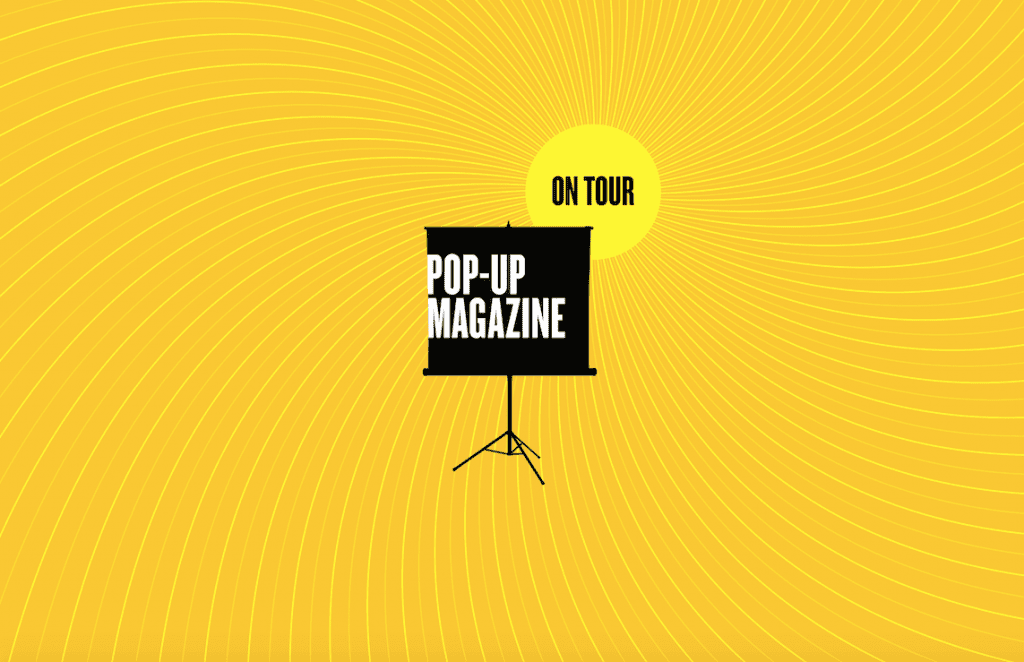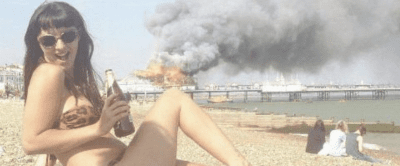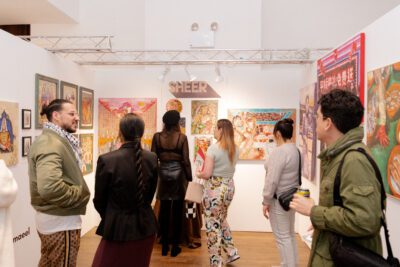Pop-Up Magazine’s Live Story Telling Magic Comes to BAM

Via Pop-Up Magazine.
What is it to tell a story? To tell a non-fiction story? Normally, we segregate stories by medium: online, print, documentary, radio, podcast. But why? Why wouldn’t we use as many of these mediums as possible, simultaneously, to tell stories that unfold with as much nuance and dimension as they did when they happened, when people lived them?
Crazy idea—until you realize, of course, it’s not crazy at all. If it could be pulled off with masterful production and exceptional reporting, an all together new and thoroughly engrossing form of narrative nonfiction could result. Doug McGray, a native of Maine, turned (current) 11-year resident of San Francisco, understood the enormous power that the combination of these story-telling mediums could unleash.
Today, the former writer for places like the New York Times Magazine, and radio producer for This American Life, is Editor-in-Chief of this not actually so crazy idea come to life. McGray began Pop-Up Magazine in 2009, as a hobby, in San Francisco. Today, the singular media company tours very big, sold-out venues across the country. Next month, Pop-Up Magazine kicks off its spring tour at BAM. (And tickets go on sale today at 3pm!)
The magazine does not release many details about their live performance shows ahead of time, except for the talent involved. This time (as usual), they’ve amassed top-notch performers from divers corners of story-telling: Daniel Alarcón (Author and founder of Radio Ambulante), Miwa Matreyek (multimedia artist and performer), Doreen St. Félix (editor-at-large at Lenny), and many, many more, from photographers, to actors, to editors, and even a chef.
Yesterday, on his way back to San Francisco from a weekend in Lake Tahoe (which made me sad, I mean very happy to hear, sitting in chilled and drizzly Brooklyn), Doug McGray took time to talk with me about the magic that is Pop Up Magazine, its compliment in print, California Sunday Magazine, and the magic of the non-recorded, non-linkable, live-performance moment.
How’s it going today in California? (Cold Brooklynite wants to know.)
Doug McGray: It’s really beautiful and snowy; I was in Lake Tahoe for the weekend and I’m headed back to the office this morning. It’s really white with lots of pine trees—nothing like your typical California image.
What made you move to the West coast from the East?
DM: I just had a Western itch, I gotta say. A lot of the things that drew me out here are things that I love. And from a media standpoint it felt really exceptional and interesting and wide-open. There are just so many great stories to tell. And San Francisco and the Bay Area and Los Angeles are really fascinating and great places to live. It’s a cliche but you can work hard during the week and then go find yourself on a mountain or some ocean beach that looks like a postcard on the weekend.
What led you to start Pop-Up Magazine?
DM: I had spent most of my career as a writer for The New Yorker and The New York Times Magazine and then I got into doing radio and producing stories for This American Life. It struck me as odd that radio was close enough to writing that I stumbled into doing it—but the professional worlds of radio and film and photographer and writing are still pretty separate. And yet together all of us are in the business of finding and telling true stories. So why not make something with all of these different media? We rented a theater with 350 seats in The Mission. Everyone had a great time and almost immediately we decided to do it again, and immediately it was impossible to get tickets. It got bigger and bigger and now we go to venues with three thousand people where tickets sell out in 15 or 20 minutes. We realized something kind of magical was going on.
How has the show evolved over time?
DM: There are all sorts of things you can do on stage that you couldn’t do if you were writing a story and making film. People started collaborating and that made things interesting. In the beginning people were reading and now it has evolved. There can be a story being told by a photographer and in animation, on screen, with a band playing an original movie soundtrack. You can get lost in a story. It doesn’t feel like anything else. It’s not like an open mic night. Everybody has gone out and reported and produced original stories and art directed. One of the nice things is everybody in the show makes a point to be really accessible to talk afterward. The whole night has a very generous, fun spirit.
In the age of the Internet where everything is about traffic and clicks, tell me about your decision to not record or share your Pop-Up Magazine performances.
DM: We’re putting a lot of care into making something for this one night. It was always really important to us to bring people together by not recording it, not filming it; there is a sense of immediacy to it, and I think you can find people paying attention in a different way. You can’t share the link the next day. If there is a story you love, you have to retell it, and remember it, and that helps give the night something special.
Is it a kind of backlash to our digital lives?
DM: It’s not a backlash to social media. We live digital lives. We love social media, it has enabled the growth of Pop-Up in some ways. We grew from a little theater into one with thousands of people. But we find it’s a nice compliment. We live a life where everything is recorded and documented and archived, and it’s nice to play around with something ephemeral, and nice for the audience to experience something that is ephemeral.
You also head up California Sunday Magazine; how does the print magazine relate directly or indirectly to Pop-Up Magazine?
DM: Pop-Up Magazine is something you do at night instead of going to see live music or to the movies; it is all these originally reported stories with art and design. But the weekend is a really interesting time, too. We started wondering how we might bring really beautiful reporting and design into stories that people can read on their leisure time, on the weekends, at home. And it seemed like there was an opportunity to do that in a beautiful way. If you live on the West Coast, you realize media, and magazine-style features especially, are massively concentrated on the East Coast.
But the West Coast is fascinating, and on the edge of Latin America and Asia. So in addition to the growth of Pop-Up Magazine, we also wanted to create a new weekend magazine to cover California, The West, Latin America and Asia and to bring the sensibility of the live show, but to take advantage of the form in the same way that we take advantage of the live stage—thinking about someone spending time on their couch at home, reading on their phone or in print or on a table in a kind of uninterrupted way. Pop-Up Magazine and California Sunday Magazine live side by side. We share the same staff and office and we are the same company. Sometimes we make stuff for live performance, and sometimes to read at home.
Tell me about one of your favorite Pop-Up Magazine moments so far.
At the last show there was a piece that everyone really loved. Jenna Wortham from the New York Times Magazine produced a story about a man that lost the ability to form memory due to injuries. He ended up turning to technology, and a lot of the technology we all use, especially his phone, to navigate his life. And it was this very not-dark story; it was a very thoughtful, beautiful story about this guy and his technology. And in a way we all use technology in a lot of the same ways, he is only a more extreme version. But all of us, we can’t get anywhere without Google Maps on our phone, and can’t remember anything without looking it up on our phones. The story was told in collaboration with our band who performed an original score. And Manual Cinema from Chicago created what essentially looks like animation on a big screen, but they’re using a series of cut-outs and lights and projection—creating the movie of her story out of shadows. You got to hear and listen to this story about a fascinating person with implications for all of us, while you watch it unfold in the shadows. And she did a really wonderful job with it.
Buy Pop-Up Magazine BAM tickets, starting today at 3pm EST! I mean it, get on it—Pop Up Magazine came to New York for the first time last fall and tickets sold out in 15 minutes. Got a story idea for future Pop-Up Magazine tours? Pitch them! It operates much like a regular magazine. Pop-Up Magazine at BAM Howard Gilman Opera House: Tuesday, April 5; 30 Lafayette Avenue, Brooklyn.
You might also like 



















